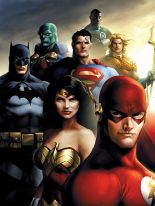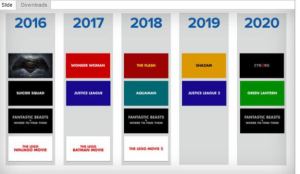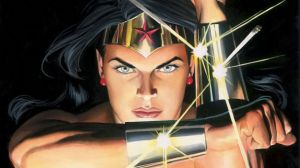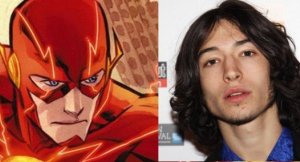
The urge to name this Love in the Time of Wonder Woman was so strong, but I resisted the impulse. While there was an ease with which the rejected article title came, it didn’t quite capture everything I wanted to cover in talking about the 35 issue run of Wonder Woman. In the three years since the New 52 launched, the creative team of writer Brian Azzarello, artists Cliff Chiang, Tony Akins, Goran Sudzuka, colorist Matthew Wilson, and letterer Jared K. Fletcher crafted a new origin for DC Comics’ first female superhero, one steeped in the old mythology of the Greek Pantheon but intent on forging ahead to create a new mythology with Wonder Woman leading the way.
For the record, though, if you’re looking for a place that will at least consider making references to the works of Gabriel García Márquez….Bam. This girl.
Moving on.
As, presumably, the introduction for new readers via the “soft reboot” of the New 52, the creative team were faced with the task of making Diana’s story within her corner of the DC Universe fantastical, entertaining, and above all else relatable. In order to do so, Azzarello and Chiang dove into the core tenants of Wonder Woman’s character as established by her creator, William Moulton Marston, and used those elements to build a story around two essential questions: Who is Wonder Woman and what does she stand for? The answer lies in the simplest yet most complex word, love. From love springs a multitude of emotions – mercy, compassion, tolerance, anger, rage, and forgiveness – all of which hinder and guide Wonder Woman in her personal journey of discovery, a journey she doesn’t make alone. Though love ends up being the answer, how Diana frames her revelations is within the context of family; her biological family of gods and demigods as well as the family she builds with her friends and rebuilds amongst the Amazons. The consequences of such a framework, however, brings about the destruction of Marston’s “paradise”, but I think that was Azzarello’s intention all along. In lieu of paradise, of some perceived utopia, Azzarello posits that family and community should be the goal and only by understanding and submitting to love can such a goal be accomplished.
 Before we go any further, and because this article will mostly be addressing Wonder Woman from a writing and thematic perspective, I wanted to talk about Cliff Chiang’s artwork on the book. Of all the redesigns in the New 52, Chiang’s Wonder Woman continues to be my favorite and is definitely in my top five versions. Chiang manages to capture the Amazon in Diana – tall, athletic, broad shoulders – making us believe that this is a woman who’s trained her whole life as a warrior. Her athletic aesthetics, however, don’t come at the cost of her femininity. Diana is gorgeous but Chiang deftly keeps away from sexualizing not just Diana but most of the book’s female characters.
Before we go any further, and because this article will mostly be addressing Wonder Woman from a writing and thematic perspective, I wanted to talk about Cliff Chiang’s artwork on the book. Of all the redesigns in the New 52, Chiang’s Wonder Woman continues to be my favorite and is definitely in my top five versions. Chiang manages to capture the Amazon in Diana – tall, athletic, broad shoulders – making us believe that this is a woman who’s trained her whole life as a warrior. Her athletic aesthetics, however, don’t come at the cost of her femininity. Diana is gorgeous but Chiang deftly keeps away from sexualizing not just Diana but most of the book’s female characters.
The modern, or ancient, redesigns of the Greek Pantheon are probably my favorite aspect of the book from an artistic  standpoint. Instead of keeping to the stereotypical depiction of the Greek gods, Chiang makes them the embodiment of their particular territory or job. Hermes the Messenger has the visage of a humanoid bird, Artemis the goddess of the hunt and the moon glows brightly while sporting antlers, looking like a marble statue, and Poseidon, lord of the seas, is a gigantic fish-like creature, a great and powerful reflection of his domain. My favorite design is probably Strife. Though her only otherworldly aspect is her purple skin, Strife looks exactly like her name. The shaved head, heavy makeup, and slashed form-fitting dress give readers an immediate sense of unease, that anything involving her will lead to trouble. Wonder Woman is definitely one of the most beautiful books from DC. It’s vibrant and bursting with energy and color thanks to Chiang and colorist Matthew Wilson.
standpoint. Instead of keeping to the stereotypical depiction of the Greek gods, Chiang makes them the embodiment of their particular territory or job. Hermes the Messenger has the visage of a humanoid bird, Artemis the goddess of the hunt and the moon glows brightly while sporting antlers, looking like a marble statue, and Poseidon, lord of the seas, is a gigantic fish-like creature, a great and powerful reflection of his domain. My favorite design is probably Strife. Though her only otherworldly aspect is her purple skin, Strife looks exactly like her name. The shaved head, heavy makeup, and slashed form-fitting dress give readers an immediate sense of unease, that anything involving her will lead to trouble. Wonder Woman is definitely one of the most beautiful books from DC. It’s vibrant and bursting with energy and color thanks to Chiang and colorist Matthew Wilson.
Okay, back to the rest of the article.
The origin of Diana of Themyscira is often one of the first elements tackled when a new creative team takes over the book or DC feels like rebooting. Unlike Krypton blowing up or Thomas and Martha Wayne being killed in Crime Alley, Wonder Woman’s backstory of being molded from clay and entering “Man’s World” has gone through several iterations since she first appeared in 1941. Because of this malleability, Wonder Woman tends to embody the attitudes of women within the modern world – 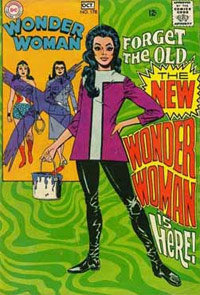 depending on who’s writing – but each retelling and reinterpretation is hit or miss depending on a number of factors, one of the most prominent being the socio-political climate. When Diana lost her powers in the 1960s in order to make her seem more like the modern day woman it was met with scorn from feminists like Gloria Steinem who accused the creative team of taking the most powerful female superhero and stripping her of her powers. The intention may have been to make Wonder Woman relevant to the modern readership, the change was inspired by Diana Rigg’s Emma Peel in The Avengers television show, but the response proved that, like Superman, Wonder Woman’s core audience of female readers looked to her as an ideal, something to strive for and emulate.
depending on who’s writing – but each retelling and reinterpretation is hit or miss depending on a number of factors, one of the most prominent being the socio-political climate. When Diana lost her powers in the 1960s in order to make her seem more like the modern day woman it was met with scorn from feminists like Gloria Steinem who accused the creative team of taking the most powerful female superhero and stripping her of her powers. The intention may have been to make Wonder Woman relevant to the modern readership, the change was inspired by Diana Rigg’s Emma Peel in The Avengers television show, but the response proved that, like Superman, Wonder Woman’s core audience of female readers looked to her as an ideal, something to strive for and emulate.
William Moulton Marston addressed this need for an iconic hero for women and girls in the 1943 issue of The American Scholar, writing:
Not even girls want to be girls so long as our feminine archetype lacks force, strength, and power. Not wanting to be girls, they don’t want to be tender, submissive, peace-loving as good women are. Women’s strong qualities have become despised because of their weakness. The obvious remedy is to create a feminine character with all the strength of Superman plus all the allure of a good and beautiful woman.
Marston very much believed that the new world order would eventually be run by women and used Wonder Woman as “psychological propaganda for the new type of woman who should…rule the world”. Unlike the violent tendencies of men and boys, girls and women had a greater emotional capacity that, he believed, made them stronger and better leaders. Wonder Woman was a figurehead for them to rally behind, a Pygmalion creation meant to embody all that women were capable of. Making Diana the princess of the Amazons who inhabited Paradise Island solidified Marston’s vision of a utopian culture of peace and prosperity run entirely by women. By venturing out into “Man’s World”, Wonder Woman brought those sensibilities  with her as she fought Nazis and enemies on the home front, teaching and showing girls that violence wasn’t the only option but should more forceful actions need to be taken they were strong enough to break the chains or ropes that bound them. For all of the bondage imagery shown in Marston’s run, there were plenty of metaphors to be gleaned regardless of what “Dr.” Wertham thought.
with her as she fought Nazis and enemies on the home front, teaching and showing girls that violence wasn’t the only option but should more forceful actions need to be taken they were strong enough to break the chains or ropes that bound them. For all of the bondage imagery shown in Marston’s run, there were plenty of metaphors to be gleaned regardless of what “Dr.” Wertham thought.
Since Marston, the depiction of Paradise Island, later named Themyscira in the 1987 relaunch, and the Amazons have gone through as many changes as Wonder Woman. While Marston envisioned utopia with an all-female society, the exploration of Amazonian culture is a fascinating aspect of the Wonder Woman canon since the environment she grows up in acts as a reflection of the character. Some writers have utilized it beautifully (The Circle from Gail Simone, Terry Dodson, and Rachel Dodson) and others not so much (Amazons Attack! from Will Pfeifer and Pete Woods). How much Diana embraces or fights against her Amazonian upbringing is no different than how any person might face their heritage and family. And it’s here where Azzarello’s stamp on Wonder Woman takes a sharp turn for better or for worse.
 The two most controversial aspects of Azzarello’s reboot were the changes made to Diana’s origin and the Amazons. In the New 52, Diana was no longer molded from clay and blessed with life from the gods. Instead it was revealed that she was the biological daughter of Hippolyta and Zeus, making her a demigod. After finding her mother turned to stone and her sister Amazons turned into snakes as punishment from Hera, Diana becomes immersed in her godly family of half brothers and sisters, uncles and aunts. In the process, she receives one final revelation about the Amazons: to continue populating the island with female warriors, the Amazons took over ships with men on board, had sex with them, kept the daughters and gave the sons to Hephaestus.
The two most controversial aspects of Azzarello’s reboot were the changes made to Diana’s origin and the Amazons. In the New 52, Diana was no longer molded from clay and blessed with life from the gods. Instead it was revealed that she was the biological daughter of Hippolyta and Zeus, making her a demigod. After finding her mother turned to stone and her sister Amazons turned into snakes as punishment from Hera, Diana becomes immersed in her godly family of half brothers and sisters, uncles and aunts. In the process, she receives one final revelation about the Amazons: to continue populating the island with female warriors, the Amazons took over ships with men on board, had sex with them, kept the daughters and gave the sons to Hephaestus.
Many a critic and Wonder Woman fan cried foul on this change in particular since Azzarello essentially turned the Amazons into rapists. I’m not here to argue that point because it’s a valid one, but I think I understand why Azzarello made the changes. Again, Marston saw an all-female society as utopia, it’s why he named the home of the Amazons Paradise Island. But anyone who’s studied the concept of utopia knows that it’s never an achievable form of society despite what the creator desires. There are plenty of historical examples and it’s rare that fiction ever depicts a utopian society as anything less than sinister. Azzarello is yet another author in this category. Prior to the discovery of Themyscira’s repopulation program, Azzarello laid the foundation that all was not well on Paradise Island. Wonder Woman was already living in London, away from the island, and her return with Zola and Hermes, plus the appearance of Strife, brings out the underlying antagonism of some of the Amazons towards Diana. Referring to her as “clay” in a derogatory manner, it’s clear that peace, tranquility, and love aren’t always present.
Azzarello is no stranger to tackling the darker side of comic book characters. Some of his best works for DC are Joker, Lex Luthor: Man of Steel, and Superman: For Tomorrow, all of which highlighted essential aspects of the characters from Azzarello’s point of view. With Wonder Woman, Azzarello is arguing that Marston’s utopia is fallible and a myth in its own right. An all-female society is no less effective than an all-male society. The Amazons are, after all, still human. By distancing themselves from “Man’s World” they’ve lost their hold on an inclusive community. This is what makes Wonder Woman so  essential. She’s the bridge between the Amazons and the outside world, but only through taking the journey of coming to terms with her own identity and what it means to be Wonder Woman, a demigod, the God of War, and the new Queen of the Amazons, does she possess the wisdom to rebuild her family on Themyscira. She cannot separate these worlds any more than she can separate her identity. They’re all parts of a whole and by melding them she’s made stronger. It’s why she pleads with her sister Amazons to accept their brothers and protect Zola and her baby against the First Born’s army. They will be stronger as a whole, as a family, and it is simply the right thing to do.
essential. She’s the bridge between the Amazons and the outside world, but only through taking the journey of coming to terms with her own identity and what it means to be Wonder Woman, a demigod, the God of War, and the new Queen of the Amazons, does she possess the wisdom to rebuild her family on Themyscira. She cannot separate these worlds any more than she can separate her identity. They’re all parts of a whole and by melding them she’s made stronger. It’s why she pleads with her sister Amazons to accept their brothers and protect Zola and her baby against the First Born’s army. They will be stronger as a whole, as a family, and it is simply the right thing to do.
 Throughout Azzarello and Chiang’s run, love is shown to be the root of Diana’s decisions and at the center of the conflict between her and the First Born. In their final confrontation, Diana ties it all together from a thematic perspective when she tells the First Born that his demand for love and power will never result in victory because he doesn’t understand that love is about submission. There have been several instances in the book where Diana was put into a position of submission – marrying Hades, tricking Artemis into “winning” a fight, the First Born’s proposal – but none of them were made out of an actual act of love. Compare this to what Diana has personally done out of genuine feelings of love; protecting Zola and her baby, forgiving a mortal Hera, helping Hades learn to love himself, and reuniting her sister and brother Amazons. She shows compassion, mercy, and forgiveness towards others because, at her core, her love for all living things is infinite. Fittingly, her last act in the final issue is an actual submissive plea to Athena to spare Zola’s life. By submitting to love and appealing to Wisdom, Wonder Woman shows us her true heroism.
Throughout Azzarello and Chiang’s run, love is shown to be the root of Diana’s decisions and at the center of the conflict between her and the First Born. In their final confrontation, Diana ties it all together from a thematic perspective when she tells the First Born that his demand for love and power will never result in victory because he doesn’t understand that love is about submission. There have been several instances in the book where Diana was put into a position of submission – marrying Hades, tricking Artemis into “winning” a fight, the First Born’s proposal – but none of them were made out of an actual act of love. Compare this to what Diana has personally done out of genuine feelings of love; protecting Zola and her baby, forgiving a mortal Hera, helping Hades learn to love himself, and reuniting her sister and brother Amazons. She shows compassion, mercy, and forgiveness towards others because, at her core, her love for all living things is infinite. Fittingly, her last act in the final issue is an actual submissive plea to Athena to spare Zola’s life. By submitting to love and appealing to Wisdom, Wonder Woman shows us her true heroism.
I know I’m not the only one who has strong feelings towards Azzarello and Chiang’s run on the book, but I feel it’s been consistently one of the strongest coming out of DC and I’m sad to see the creative team go. There’s certainly plenty to unpack within those 35 issues, but this is just a portion of what I’ve taken away from it. But I’m interested to know what other people think.
Just, ya know, be civil. We’re all friends here.




 depending on who’s writing – but each retelling and reinterpretation is hit or miss depending on a number of factors, one of the most prominent being the socio-political climate. When Diana lost her powers in the 1960s in order to make her seem more like the modern day woman it was met with scorn from feminists like Gloria Steinem who accused the creative team of taking the most powerful female superhero and stripping her of her powers. The intention may have been to make Wonder Woman relevant to the modern readership, the change was inspired by Diana Rigg’s Emma Peel in The Avengers television show, but the response proved that, like Superman, Wonder Woman’s core audience of female readers looked to her as an ideal, something to strive for and emulate.
depending on who’s writing – but each retelling and reinterpretation is hit or miss depending on a number of factors, one of the most prominent being the socio-political climate. When Diana lost her powers in the 1960s in order to make her seem more like the modern day woman it was met with scorn from feminists like Gloria Steinem who accused the creative team of taking the most powerful female superhero and stripping her of her powers. The intention may have been to make Wonder Woman relevant to the modern readership, the change was inspired by Diana Rigg’s Emma Peel in The Avengers television show, but the response proved that, like Superman, Wonder Woman’s core audience of female readers looked to her as an ideal, something to strive for and emulate.



